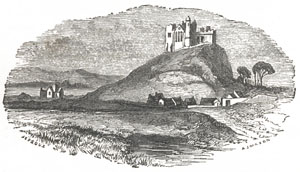Death of Cormac MacCullinan
Flahertach survived the battle, and, after some years spent in penance, became once more minister, and ultimately King of Munster. As he advanced in years, he learned to love peace, and his once irascible temper became calm and equable.

The Rock of Cashel, and the ruins of a small but once beautiful chapel, still preserve the memory of the bishop-king. His literary fame also has its memorials. His Rule is contained in a poem of fourteen stanzas, written in the most pure and ancient style of Gaedhilic, of which, as well as of many other languages, the illustrious Cormac was so profound a master. This Rule is general in several of its inculcations; but it appears to have been written particularly as an instruction to a priest, for the moral and spiritual direction of himself and his flock. He was also skilled in the Ogham writings, as may be gathered from a poem written by a contemporary, who, in paying compliments to many of the Irish kings and chiefs, addresses the following stanza to Cormac:—
"Cormac of Cashel, with his champions,
Munster is his,—may he long enjoy it!
Around the King of Raith-Bicli are cultivated
The letters and the trees."
The death of Cormac is thus pathetically deplored by Dallan, son of Môr:—
"The bishop, the soul's director, the renowned, illustrious doctor,
King of Caiseal, King of Farnumha: O God! alas for Cormac!"
Flann's last years were disturbed by domestic dissensions. His sons, Donough and Conor, both rebelled against him; but Nial Glundubh (of the black knee), a northern Hy-Nial chief, led an army against them, and compelled them to give hostages to their father. Flann died the following year, A.D. 914, and was succeeded by the prince who had so ably defended him. Meanwhile, the Danes were not idle. Amlaff [5] has signalized his advent by drowning Conchobhar, "heir apparent of Tara;" by slaying all the chieftains of the Deisi at Cluain-Daimh; by killing the son of Clennfaeladh, King of Muscraighe Breoghain; by smothering Machdaighren in a cave, and by the destruction of Caitill Find (Ketill the White) and his whole garrison. Oisill is the next chief of importance; and he "succeeded in plundering the greatest part of Ireland." It is not recorded how long he was occupied in performing this exploit, but he was eventually slain, and his army cut off, by the men of Erinn.
The deaths of several Danish chieftains occured about this period, and are referred to the vengeance of certain saints, whose shrines they had desecrated. In A.D. 864 according to the Four Masters, 867 according to O'Flaherty, the Danes were defeated at Lough Foyle, by Hugh Finnliath, King of Ireland. Soon after, Leinster and Munster were plundered by a Scandinavian chief, named Baraid, who advanced as far as Ciarraighe (Kerry): "And they left not a cave under ground that they did not explore; and they left nothing, from Limerick to Cork, that they did not ravish." What treasures the antiquarian of the nineteenth century must have lost by this marauder! How great must have been the wealth of the kings and princes of ancient Erinn, when so much remains after so much was taken!
In 877 the Black Gentiles took refuge in Scotland, after suffering a defeat in an engagement with the White Gentiles. They were, however, consoled by a victory over the men of Alba, in which Constantine, son of Kenneth, was slain, and many others with him. Their success proved beneficial to Ireland, for we are told that a period of "rest to the men of Erinn" ensued. The Danes still held their own in Dublin and at Limerick, occasionally plundered the churches, and now and then had a skirmish with the "men of Erinn;" but for forty years the country was free from the foreign fleets, and, therefore, enjoyed a time of comparative quiet.
Notes
[5] Amlaff.—Dr. Todd identifies Amlaff with Olaf Huita (the white), of Scandinavian history, who was usually styled King of Dublin, and was the leader of the Northmen in Ireland for many years. See ''Introduction" to the Wars of the Gaedhil, p. 69.
